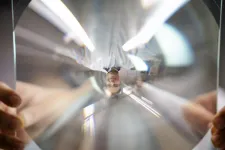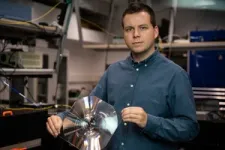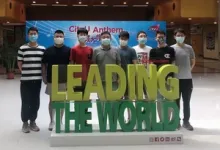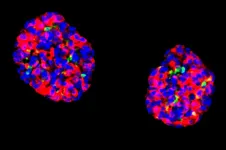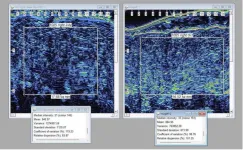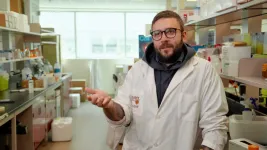Researchers at the University of Warsaw's Faculty of Physics have developed a new, highly efficient technique that makes quantum information transmission dozens of times faster. The results of the research, published in the prestigious journal Nature Photonics, may in the near future contribute to the development of superfast quantum Internet connections.
Light is a key carrier of information. It enables high-speed data transmission around the world via fiber-optic telecommunication networks. This information-carrying capability can be extended to transmitting quantum information by encoding it in single particles of light (i.e., photons). “To efficiently load single photons into quantum information processing devices, they must have specific properties: the right central wavelength or frequency, a suitable duration, and the right spectrum”, explains Dr. Michał Karpinski, head of the Quantum Photonics Laboratory at the Faculty of Physics of the University of Warsaw, and an author of the paper published in “Nature Photonics”.
Researchers around the globe are building prototypes of quantum computers using a variety of techniques, including: trapped ions, quantum dots, superconducting electric circuits, and ultracold atomic clouds. These quantum information processing platforms operate on a variety of time scales: from picoseconds through nanoseconds to even microseconds.
Time lens
In order to connect such devices together to create a quantum network, an interface is needed to change the characteristics of transmitted quantum pulses of light (i.e., single photons). A prototype of such a converter was already presented in “Nature Photonics” by the researchers from the University of Warsaw and international collaborators back in 2016. “The device presented there allowed for a six-fold change in the duration of a single-photon pulse, with an efficiency of more than 30 percent,” Dr. Michal Karpinski clarifies. He adds that the technique his team used at the time – simple electro-optic modulation – has technical limitations that allow for a maximal ten-fold change in the pulse duration. “In our new publication, we present a converter that allows for up to a 200-fold change in the pulse duration, with an efficiency of 25 percent. This means that the resulting quantum Internet link could operate up to 50 times faster,” Dr. Karpinski says.
The critical element of the new technique developed by researchers at the UW Faculty of Physics is a so-called time lens. “A classical spatial lens, the kind we are normally familiar with, changes the size of a beam of light, either focusing it or diverging it. For example, light can be focused by using a convex lens – one in which the thickness of the lens’ glass decreases with increasing distance from its center. By a similar principle, a time lens can either shorten or lengthen light pulses, but here the effective optical thickness of the glass changes in time, not in space,” explains Dr. Filip Sosnicki of the Quantum Photonics Laboratory, who was responsible for developing the experiment.
“To focus a wide beam of light using a spatial lens, it must be large enough. But this will make the lens highly convex, significantly increasing the amount, and therefore the weight, of the glass required to make it. To avoid this, we can use a Fresnel lens, whose specific shape reduces the thickness of such a lens to just a few millimeters or less,” Dr. Sosnicki explains. Due to their much smaller thickness, Fresnel lenses are used in a variety of applications, including car headlights, lighthouses, railroad signals, and even smartphone cameras. “In our research, we developed a temporal equivalent of such a lens, which we call a Fresnel time lens,” Dr. Sosnicki goes on to note.
Strong effect without destroying the lens
To create a time lens, the researchers took advantage of the electro-optic effect exhibited by some crystals. It allows the refractive index of a crystal (in this case, lithium niobate) to be altered, depending on changes in an external electric field applied to it. Using fast electric signals, it is possible to achieve a time-varying optical thickness of the crystal, which then implements the time lens. “This effect has its limitations, as excessively high electric field can destroy the crystal. In the technique we developed, we increase the refractive index in stages, similar to a spatial Fresnel lens. This way, we achieve a strong effect without destroying the lens, which, in turn, allows for more extensive modifications of quantum light pulses,” explains Dr. Karpinski. Such “staged” operations require the use of ultrafast microwave electronics. “For comparison – high-speed Wi-Fi or 5G networks operate at frequency bands of about 3 to 5 GHz, whereas our signals are more than 7 times faster, with frequencies as high as 35 GHz,” Dr. Sosnicki adds.
In further research, the scientists from the UW Faculty of Physics will test interfacing between different types of quantum information processing platforms and increase the photon transmission distance. “So far, we have been transferring single photons between devices in one laboratory. Next, we will try to perform such transfers between different buildings and even cities,” adds Dr. Michal Karpinski.
The work carried out by Dr. Michal Karpinski's group is an important step on the pathway toward creating quantum networks – both small ones, which can be used in a single quantum computer, and vast ones, enabling quantum information transfer between quantum computers in different parts of the world, thus giving rise to the quantum Internet.
The project was carried out in part under the First TEAM program (no. POIR.04.04.00-00-5E00/18) and the Homing program (no. POIR.04 .04.00-00-1E2B/16) of the Foundation for Polish Science co-financed with EU funds from the European Regional Development Fund within the framework of the Intelligent Development Operational Program, and in part as a result of the QuantERA QuICHE research project (no. 2019/32/Z/ST2/00018) and the Preludium project (no. 2019/35/N/ST2/04434), funded by the National Science Center.
Physics and astronomy at the University of Warsaw appeared in 1816 as part of the then Faculty of Philosophy. In 1825, the Astronomical Observatory was established. Currently, the Faculty of Physics at the University of Warsaw consists of the following institutes: Experimental Physics, Theoretical Physics, Geophysics, the Department of Mathematical Methods and the Astronomical Observatory. The research covers almost all areas of modern physics, on scales from quantum to cosmological. The Faculty's research and teaching staff consist of over 200 academic teachers, 88 of whom are professors. About 1,100 students and over 170 doctoral students study at the Faculty of Physics at the University of Warsaw.
SCIENTIFIC PUBLICATION:
Filip Sośnicki, Michał Mikołajczyk, Ali Golestani, Michał Karpiński, Interface between picosecond and nanosecond quantum light pulses, https://www.nature.com/articles/s41566-023-01214-z
CONTACT:
Dr. Michał Karpinski
Faculty of Physics of the University of Warsaw
phone: +48 22 5532740, +48 22 5546872
email: michal.karpinski@fuw.edu.pl
Dr. Filip Sosnicki
Faculty of Physics of the University of Warsaw
phone +48 22 5546872
email: filip.sosnicki@fuw.edu.pl
Agnieszka Fiedorowicz
Faculty of Physics of the University of Warsaw
email: agnieszka.fiedorowicz@fuw.edu.pl
phone: +48 500535090
RELATED WEBSITES WWW:
https://www.optics.fuw.edu.pl/grupy/laboratorium-fotoniki-kwantowej
Website of Quantum Photonics Lab at the Faculty of Physics of the University of Warsaw
https://www.fuw.edu.pl
Website of the Faculty of Physics of the University of Warsaw
https://www.fuw.edu.pl/press-releases.html
Press service of the Faculty of Physics of the University of Warsaw
GRAPHIC MATERIALS:
FUW230525b_fot01
https://www.fuw.edu.pl/tl_files/press/images/2023/FUW230525b_fot01.jpg
An image of Dr. Michal Karpinski obtained using a standard Fresnel lens (photo: Miroslaw Kazmierczak, source: University of Warsaw).
FUW230525b_fot02
https://www.fuw.edu.pl/tl_files/press/images/2023/FUW230525b_fot02.jpg
Dr. Filip Sosnicki with a standard, spatial Fresnel lens. Its temporal analogue was used in the conducted research (photo: Miroslaw Kazmierczak, source: University of Warsaw).
END
